A Closer Look at Plastic 3D Printing Materials
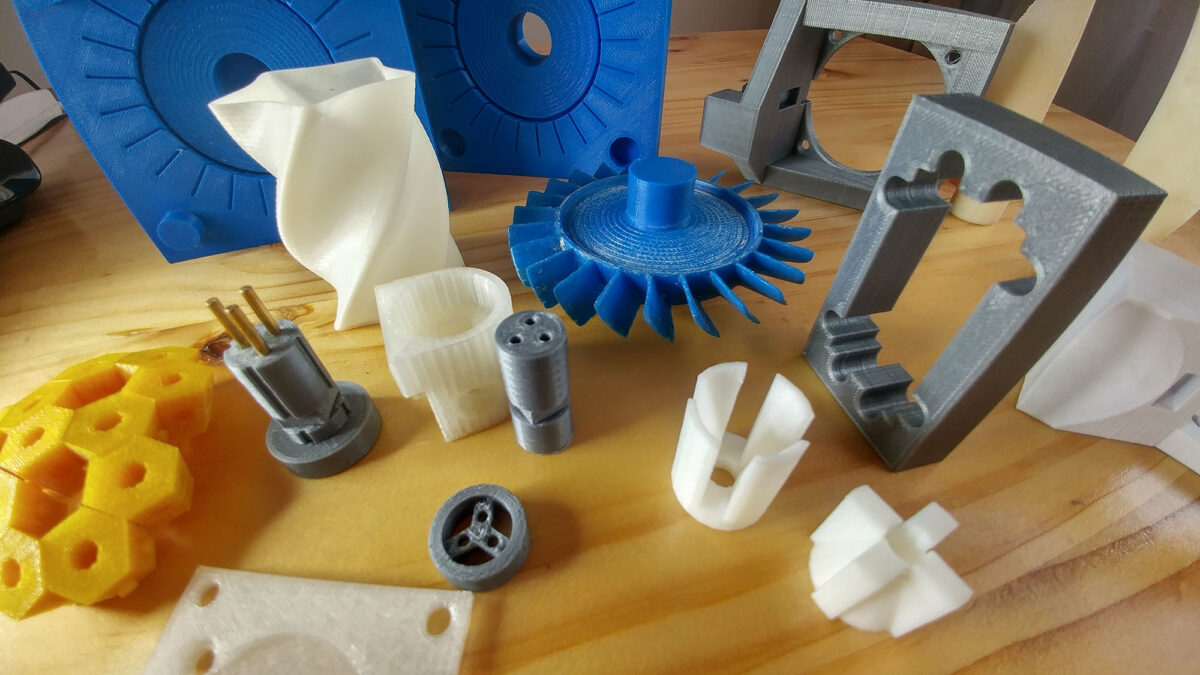
Delve into the realm of 3D printing plastics where innovation meets engineering. From traditional petroleum-based materials to eco-friendly alternatives like polylactic acid (PLA), discover the versatile and ever-evolving world of plastics. While Fused Deposition Modeling (FDM) remains popular for rapid prototyping, advanced technologies like Selective Laser Sintering (SLS) and Stereolithography (SLA) bring unparalleled precision for industrial applications. Uncover how these plastics shape the future of manufacturing and engineering.
What plastics can be used in additive manufacturing? In filament or powder form, the plastic should melt to form the object you are printing layer by layer. In resin form, it should solidify to form the object. Each plastic will require different 3D printing parameters during the building process, and will give parts varying properties. In the following guide, we give an overview of different plastic materials that can be used in 3D printing.
ABS, or Acrylonitrile Butadiene Styrene
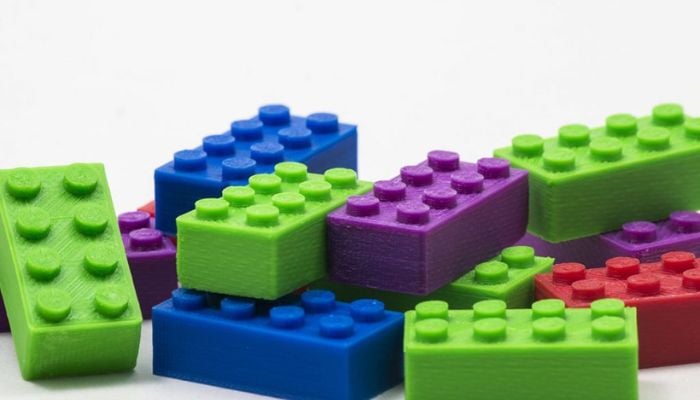
Parts made from ABS. Courtesy of Simplify3D
ABS, or Acrylonitrile Butadiene Styrene, takes the center stage in the world of plastics for engineers. Its ubiquity ranges from household names like Lego bricks to automotive parts, household appliances, and roofing applications. ABS, a thermoplastic with a polybutadiene elastomer base, offers flexibility and exceptional impact resistance. It’s a key player in Fused Deposition Modeling (FDM), making it a staple in desktop 3D printing. Available in resin form, ABS complements SLA and material jetting processes.
With a print temperature spanning 230°C to 160°C, ABS thrives in extreme temperature conditions, from -20°C to 80°C. Its standout features include robust strength, a polished surface finish, reusability, and weldability using acetone-based chemical processes. Yet, it’s non-biodegradable and susceptible to shrinkage upon exposure to air, necessitating a heated build platform and an enclosed 3D printer. Maintaining a closed chamber reduces particle emissions during printing.
PLA, or Polylactic Acid
PLA, or Polylactic Acid, shines as a biodegradable alternative to ABS, sourced from renewable corn starch. Its minimal 3D printing shrinkage eliminates the need for a heated build plate. Printing temperatures in the range of 190°C to 230°C are ideal. Yet, its swift cooling and curing pose handling challenges. Water contact can mar its appearance. However, this translucent material enjoys wide usage in FDM 3D printers, with an array of color options.
ASA, or Acrylonitrile Styrene Acrylate
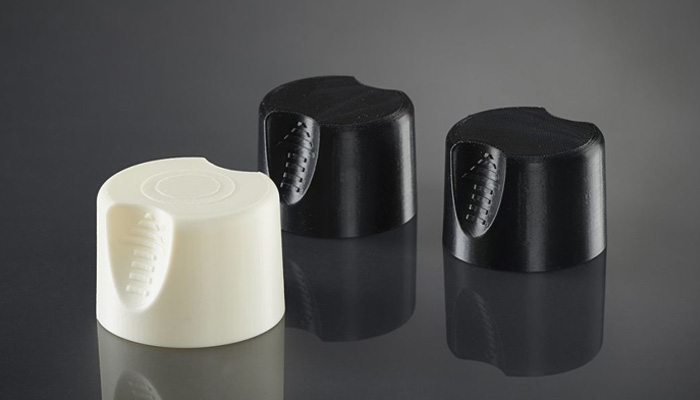
Spray paint can caps. Courtesy of Stratasys
Acrylonitrile Styrene Acrylate (ASA) closely resembles ABS but excels in UV resistance. It’s advisable to employ a heated plate during printing. ASA’s printing parameters align with ABS, but precautions are needed due to styrene emissions. Printed ASA components exhibit robust stability.
PET, or Polyethylene Terephthalate
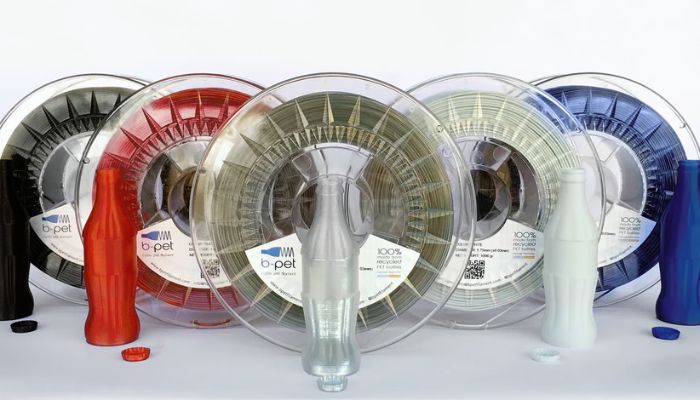
3D-printed bottles made from recycled PET bottles. Courtesy of b-Pet
Polyethylene Terephthalate, or PET, commonly used in disposable bottles, is ideal for food-contact objects. Its semi-rigid nature and resistance make it a valuable choice. Optimal printing requires temperatures of 75-90°C. Available as translucent filament, it includes PETG, PETE, and PETT variants. PET is odor-free during printing and entirely recyclable.
PETG, or Glycolized Polyester
PETG, or glycolized polyester, is a versatile thermoplastic in the additive manufacturing sector, offering the ease of PLA 3D printing and the durability of ABS. As an amorphous plastic, it’s fully recyclable. PETG shares its chemical composition with PET, but glycol is added to enhance flexibility and reduce brittleness, making it a resilient choice for various applications.
PC, or Polycarbonate

Polycarbonate (PC), engineered for demanding technical applications, excels in its resistance to high temperatures, remaining unyielding up to 150°C. Notably, PC is moisture-absorbent, impacting its performance and compressive strength over time. To maintain its properties, airtight storage is recommended. Within the additive manufacturing realm, PC is prized for its strength and optical clarity. With a lower density than glass, it becomes a compelling choice for crafting visually transparent components, protective screens, or decorative items.
High-Performance Plastics (PEEK, PEKK, ULTEM)
The continuous evolution of 3D printing technologies has ignited extensive exploration of advanced printing materials, birthing a spectrum of high-performance filaments with mechanical properties akin to metals. High-performance plastics like PEEK, PEKK, and ULTEM, hailing from the polyaryletherketones (PAEK) and polyetherimides (PEI) families, stand out. Notable for their exceptional mechanical and thermal resilience, coupled with a reduced weight compared to metals, they hold immense appeal in aerospace, automotive, and medical realms.
High-performance polymers can be processed by various FDM printers, but it necessitates equipment with a hot plate reaching 230°C, 350°C extrusion capability, and a sealed chamber. Presently, around 65% of these materials are FDM-produced, but they are also available in powder form for SLS.
PP, or Polypropylene
Polypropylene, extensively employed in the automotive and textile industries, as well as the production of numerous everyday objects, boasts commendable attributes. Renowned for its wear resistance, shock-absorbing capacity, and the delicate balance between hardness and flexibility. Nonetheless, PP does exhibit susceptibility to low temperatures and UV-induced expansion as its notable drawbacks.
Composites
Composites offer an exceptional advantage by enabling the production of lightweight yet incredibly robust components. The integration of fibers enhances structural integrity without adding unwarranted weight, earning them the title of fiber-reinforced materials. Two primary reinforcement categories exist: short fiber and continuous fiber. Short fibers, consisting of segments under one millimeter, are blended with conventional 3D printing plastics like nylon, ABS, or PLA, amplifying stiffness and strength. On the other hand, continuous fibers remain unbroken, with carbon fiber being the preferred choice, although alternatives such as fiberglass or Kevlar are also available.
Hybrid Materials
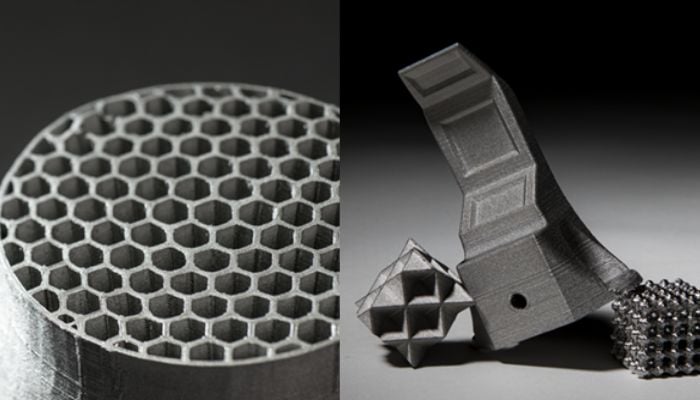
Courtesy of BASF
Various materials employ a PLA base mixed with powders to impart distinct colors or surface textures. Typically, these filaments consist of 70% PLA and 30% hybrid material. Presently, the market offers filaments infused with diverse materials like bamboo, cork, wood, among others, providing the final structure with an organic touch. Additionally, FDM technology serves as the foundation for metal extrusion, with companies such as Colorfabb and BASF offering 3D metal filament. This choice allows for 3D printed objects in varying metal colors, including copper, bronze, silver, and more.
Soluble Materials
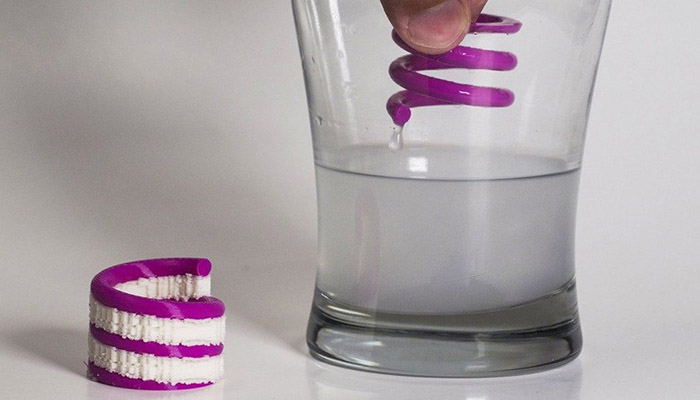
Courtesy of Simplify3D
Soluble materials are designed for printing and subsequent dissolution in the manufacturing process. The prevalent soluble filament materials include HIPS (High Impact Polystyrene) and PVA (Polyvinyl Acetate). HIPS, akin to ABS, dissolves with limonene, while PVA dissolves in water (up to 70°C). Emerging in popularity are BVOH filaments, especially in dual-extruder printers, renowned for their superior water solubility, surpassing even PVA, according to experts.
Flexible Materials
Flexible plastic filaments, such as TPE or TPU, have gained prominence in the 3D printing arena. These materials enable the production of pliable parts. They share many printing characteristics with PLA but offer varying degrees of flexibility. Ensuring material compatibility with the extruder is advisable to prevent nozzle clogging.
PA, or Polyamide
Polyamide, commonly used in objects produced through SLS technology from fine, white, granular powder, is also available in filament form for Fused Deposition Modeling (FDM). Renowned for its biocompatibility, polyamides are suitable for creating food-contact parts (excluding those with alcohol).
Characterized by semi-crystalline structures, polyamides strike a balance between chemical and mechanical properties. They offer stability, stiffness, flexibility, and impact resistance. This versatility makes polyamides invaluable across various industries, delivering high detail and quality. From gears and aerospace components to medical prosthetics and injection molds, polyamides find applications in a wide array of fields.
Alumide
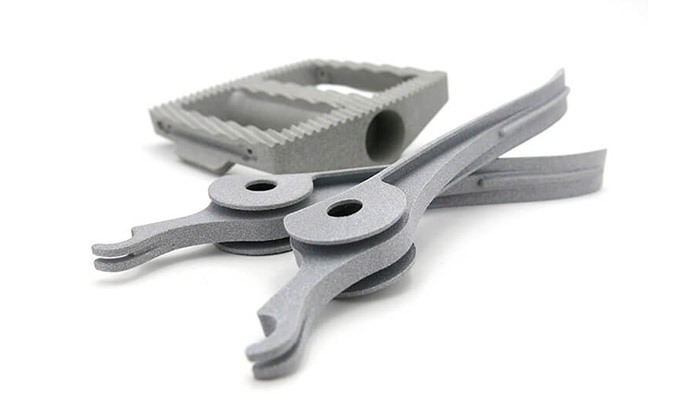
Courtesy of Sculpteo
Alumide, crafted through the SLS method by blending polyamides and aluminum powder, boasts robustness and temperature resistance (up to 172°C) but exhibits a slightly porous, granular surface. Post-processing steps like grinding, coating, or milling may be necessary when working with Alumide. This material shines in crafting intricate models, design components, and small-batch functional models that demand both high stiffness and an aluminum-like appearance. It offers ample creative freedom due to minimal geometric restrictions.
Which plastics have you already used for 3D printing? Let us know in a comment below or on our LinkedIn!
